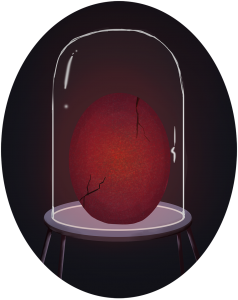A Report by J.M. Cadogan RSSc, AHME, BS, MS (Birm), MS (Oxon). Presented by Archivist to The Society, Mark Wardecker.
Art by Katie Nyborg
We all thought de Groot was a crank, and that is why I bear no grudge toward any member of our Society. Like myself, you had no reason to believe that the errand upon which you had sent me could have been any more than the routine debunking of a charlatan. In fact, as I prepare myself to write this account of de Groot and his “creation,” it strikes me that I myself may be accused of attempting to deceive you, for the facts of the case seem fabulous even to me, and I have little to offer in the way of evidence, just what is left of de Groot and his machine. For the rest, I hope you will rely upon my reputation as a man who stands flat-footed upon the ground, a scientist–like most of you–but no theoretician, simply an inventor.
For those of you still unfamiliar with the circumstances surrounding this report, it was precipitated by a letter from Dr. Oswald de Groot, a physicist lately retired from academic life. It was early in the evening, and following dinner, we had all congregated before the fire in the walnut-paneled Members’ Room of the Society’s library for cigars and aperitifs. By way of a joke, Farnham produced de Groot’s letter, delivered earlier in the day. It was characteristically flamboyant and read:
“My work has progressed to the point where I have begun to assay the role of God himself. I have created life. Please send a representative to my home in Sussex to confirm, and all will be made clear.”
“You don’t suppose he’s impregnated his chamber maid?” asked Morrow.
“Doubtful–there are limits to what even science can accomplish!” Larson fired back.
“Seriously, though,” snuffled Farnham, “Does anyone know what de Groot’s been about lately? What could possibly be the meaning of this?”
“Last I heard, he was experimenting with magnets,” I recalled.
“To create life?”
“No, something that is obviously even further beyond his ken–invisibility.”
And with that, I assumed I had managed to dispel the last hint of decorum, but Farnham, as the last few chuckles subsided, declared, “Well, as this Society’s president, for form’s sake, I suppose I must appoint one of you to go and examine this buffoonery.”
It was at this point that I came to regret my earlier remarks, since my passing familiarity with de Groot’s recent work (and because the other likely candidate, the naturalist, Edwards, was conveniently busying himself with retrieving a match he had dropped beneath a chair) procured me the privilege of investigating the claim. I resigned myself to a trip to Sussex the following afternoon.
- It was massive, the size of an ostrich egg, but completely unblemished, with a hint of phosphorescence about it. Whatever de Groot’s claims, this was unnatural, a real discovery. We would likely need a naturalist after all.
To read the rest of this story, check out the Mad Scientist Journal: Winter 2013 collection.
Though not a mad scientist himself (or, rather, not yet), J.M. Cadogan has met more than his fair share of them through the august Society of which he is a senior member. It was, in fact, during the events described in the report featured here, that he began a long career of investigating such characters. Prior to that, he was best known for his innovative mechanical contributions to the Empire’s railways.”
Mark Wardecker has been a great admirer (from a safe distance) of mad scientists since his first exposure to Peter Cushing’s Victor Frankenstein and his various monsters from hell. His fiction and non-fiction have appeared in Sherlock Holmes Mystery Magazine, The Willows, Doctor Who and Philosophy, and the Baker Street Journal. He has also edited an anthology of August Derleth’s early Solar Pons stories and is a librarian at the University of Illinois at Urbana-Champaign.
Katie Nyborg’s art, plus information regarding hiring her, can be found at http://katiedoesartthings.tumblr.com/
Follow us online:
